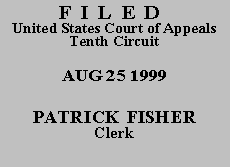

| DONALD R. HUDSON,
Plaintiff-Appellant, v. KENNETH S. APFEL, Commissioner, Social Security Administration, Defendant-Appellee. |
|
Plaintiff Donald R. Hudson appeals from the denial of social security disability benefits. He argues that the administrative law judge (ALJ) improperly denied the case at step five: (1) by relying on the absence of evidence to find that he could perform the full range of light work unlimited by any significant nonexertional impairments, and by failing to link his credibility findings to the evidence; and (2) by relying on expert vocational testimony that was elicited by improper hypothetical questions. We have jurisdiction under 28 U.S.C. § 1291 and 42 U.S.C. § 405(g).
Plaintiff was born on March 6, 1952. His past work was as an oil field worker. The vocational expert (VE) testified that this was heavy, semi-skilled work. Plaintiff alleges that he became disabled on June 10, 1992, as a result of an episode of Bell's Palsy, severe lower back pain, high blood pressure, diabetes, a separated left shoulder, left arm numbness, and blurred eyesight.
The ALJ decided the claim at step five of the evaluation sequence. See generally Williams v. Bowen, 844 F.2d 748, 750-52 (10th Cir. 1988) (discussing the five steps). Reviewing the medical evidence, the ALJ noted that plaintiff's diabetes was well controlled, see Appellant's App., Vol. II at 12; that his episode of Bell's Palsy was resolved, see id. at 10; that his vision, with correction, was within normal limits, see id. at 12; and that he did not seek treatment for, or take medication for, his alleged back pain or any orthopedic complaint, see id. at 10-11. The ALJ found at step two that plaintiff's diabetes was a severe impairment, and that his other impairments of arthritis, chest pain, and shortness of breath were not severe. At step four, he found that plaintiff was capable only of light work, and therefore could not return to his past, heavy work. At step five, the ALJ determined that plaintiff was not limited by any significant nonexertional impairments, had a limited education, and was a younger individual. Although the ALJ questioned a VE, he based his conclusion that plaintiff was not disabled on Rule 202.18 from the medical-vocational guidelines (the "grids"), 20 C.F.R. pt. 404, subpt. P, app. 2.
Plaintiff's argument on his first issue is focused solely on a statement in the ALJ's decision that "[t]here is no support in the record for a finding that claimant cannot occasionally perform tasks requiring bending, stooping, and all other postural activities consistent with light work." See Appellant's App., Vol. II at 13. Citing Thompson v. Sullivan, 987 F.2d 1482, 1491 (10th Cir. 1993), plaintiff asserts that the ALJ improperly relied on "the absence of contraindication in the [claimant's] medical records" to make this finding. See Appellant's Br. at 21. However, the particular statement challenged by plaintiff was part of the ALJ's assessment of plaintiff's residual functional capacity (RFC). See 20 C.F.R. § 404.1545(b). The determination of a claimant's RFC is made at step four, see Winfrey v. Chater, 92 F.3d 1017, 1023 (10th Cir. 1996), where the claimant bears the burden of proof. See Nielson v. Sullivan, 992 F.2d 1118, 1120 (10th Cir. 1993). The ALJ therefore did not err by pointing out that plaintiff had not presented medical evidence to establish any postural limitations. To the extent that plaintiff may be arguing that the ALJ's finding, at step five, that he had no significant nonexertional impairments is not properly supported, we hold that the ALJ's finding is supported by substantial evidence. We reject plaintiff's contention that the ALJ failed to link his credibility determination to the evidence. The ALJ adequately reviewed the medical evidence, and it does not support plaintiff's claim for benefits.
Plaintiff's second issue is without merit. The ALJ relied conclusively on the grids and did not rely on the VE's testimony. Assuming arguendo that the ALJ erred in formulating his hypothetical questions, the errors did not affect his decision.
AFFIRMED.
Entered for the Court
Circuit Judge
*. This order and judgment is not binding precedent, except under the doctrines of law of the case, res judicata, and collateral estoppel. The court generally disfavors the citation of orders and judgments; nevertheless, an order and judgment may be cited under the terms and conditions of 10th Cir. R. 36.3.